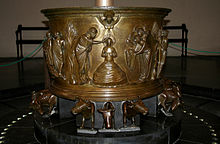Brazen sea
According to the Bible, the Brazen Sea (Hebrew יָם [jam]: sea) was a large bronze water basin as part of the Temple of Solomon .
Biblical report
The 1st Book of Kings tells of Solomon's temple building:
23 And he made the poured sea ten cubits wide from one edge to the other, round and five cubits high, with a cord of thirty cubits all around. 24 And around the sea there were tendrils around its edge, ten to a cubit; it had two rows of tendrils that were cast with the casting. 25 And it stood on twelve cattle, three of them facing north, three facing west, three facing south, and three facing east, with the sea on top, with their hindquarters all turned inward. 26 But the wall of the sea was a hand's breadth, and its rim was like the rim of a cup, like an open lily, and two thousand buckets went inside. (1 Kings 7: 23-26, King James Version)
The specified dimensions correspond to a diameter of 5 m and a height of 2.50 m. “Such large metal basins in the temple area were typical of the Syrian and Hittite areas,” while the Egyptians created ponds at their temples.
King Ahaz made changes: " And he took the sea down from the bronze oxen that were under it and set it on a stone pavement ." (2 Kings 16:17)
After the Babylonians conquered Jerusalem in 597 BC. And the destruction of the temple, there are no further reports about the sea of bronze.
Cultural background
There were comparable water basins in Mesopotamian temples, which were called ab / apsû , "fresh water ocean ". Neo-Assyrian reliefs show metal basins that stand in front of temples, e.g. T. on cattle figures.
Cattle as carrier figures are often attested in the ancient Orient. They symbolize "power, struggle and strength."
Exegetical considerations
According to Othmar Keel, the sea of bronze represented the chaos water tamed in creation, the tank wagons the streams with living water emanating from the temple.
The Israelites were not a seafaring nation: “Most of the time, according to the Old Testament, ancient oriental worldview, the sea is considered a“ water desert ”(analogous to the“ dry desert ”) and thus a chaotic, hostile area that faces the inhabited cultural world. It is one of those greats that repeatedly threaten the divine world order and therefore has to be tamed (( Ps 46,4 LUT ); ( Ps 93,3 LUT )). "
reception
Medieval Christianity
In his commentary on the 1st Book of Kings, Rupert von Deutz interpreted the Brazen Sea as the prototype of the Christian baptismal font . The twelve cattle symbolized the twelve apostles .
The baptismal font by Reiner von Huy from 1118 is one of the rare adoptions of the motif for the design of a Christian baptismal font. (today in St. Barthelémy in Liège )
Mormon temples

The Mormonism refers in his temples positively to the Temple of Solomon. All temples have a large baptismal font for the vicarious baptism of the deceased , which rests on 12 cattle figures.
literature
- Othmar Keel : The world of ancient oriental symbolism and the Old Testament : Using the example of the psalms, Vandenhoeck & Ruprecht 1972.
- Othmar Keel / Ernst Axel Knauf / Thomas Staubli : Solomons Temple. Academic Press Friborg, Freiburg (Switzerland) 2004, ISBN 3-7278-1459-4 .
- Wolfgang Zwickel : The world of the Old and New Testaments . A non-fiction and work book, Calwer Verlag Stuttgart 1997, ISBN 3-7668-3412-6 .
Web links
- Michaela Bauks: Art. Primordial Sea , in: WiBiLex
- Hans Martin von Erffa, Ehernes Meer, in: Reallexikon zur Deutschen Kunstgeschichte, Vol. IV (1956), Sp. 837–844; in: RDK Labor
Individual evidence
- ↑ Wolfgang Zwickel: The world of the Old and New Testaments . S. 222-223 .
- ↑ Othmar Keerl et al .: Solomon's Temple . S. 24 .
- ↑ Othmar Keel: The world of ancient oriental pictorial symbolism . S. 120 .
- ↑ Othmar Keel et al .: Solomon's Temple . S. 24-25 .
- ^ Klaus Koenen: Art. Bull pictures. In: WiBiLex. Retrieved December 16, 2017 .
- ↑ Othmar Keel et al .: Solomon's Temple . S. 26 .
- ↑ Peter Riede: Art. Sea. In: WiBiLex. Retrieved December 16, 2017 .
- ^ Migne, Patrologia Latina 167, columns 1166 to 1169
